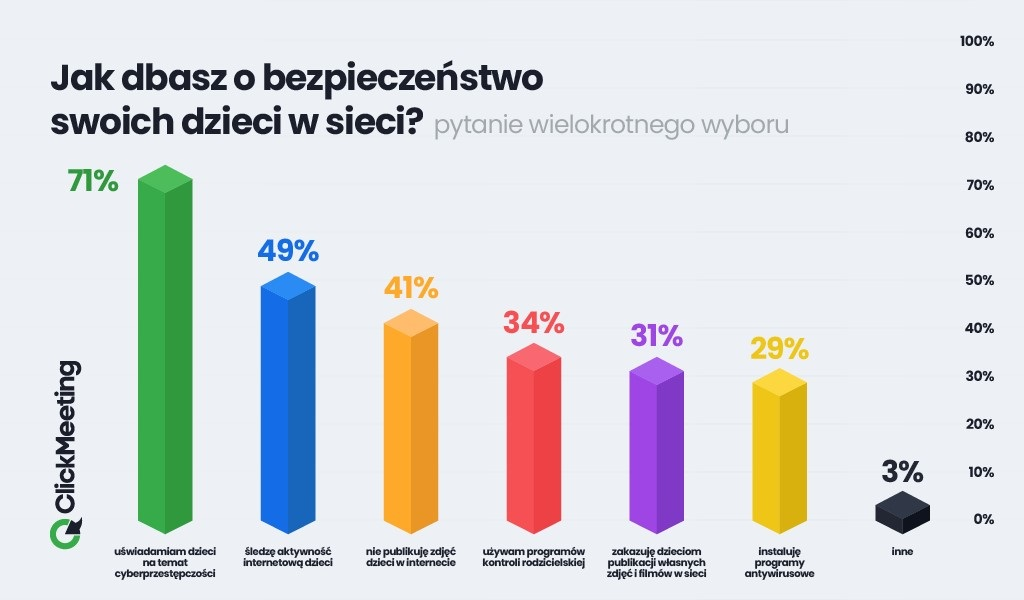 source: Clickmeeting Academy
source: Clickmeeting AcademyHow do parents protect their children’s online safety? Clickmeeting, a platform for webinars and online events, investigated this question. A survey conducted as part of the Clickmeeting Academy revealed the following:
- the most common approach (71%) is educating children about cybercrime,
- followed by monitoring the child’s internet activity (49%),
- not posting photos of children online (41%),
- using parental control software (34%),
- prohibiting children from posting their own photos and videos online (31%),
- and installing antivirus software (29%).
- For children, the virtual world is a natural part of their reality where they grow up. It’s the role of parents to show them how to use the internet wisely and keep them safe in the online world, comments Martyna Grzegorczyk from ClickMeeting in a statement summarizing the study results.
What about privacy?
It turns out that 43% of respondents say they protect their child’s privacy every time, and 48% not always, but they try. Only 7% admitted they don’t care about their children’s online privacy at all, because they don’t know how, and 1% of respondents even said they don’t care about children’s privacy online because it doesn’t matter to them.
At the same time, 54% of respondents believe their children are aware of online dangers, 36% do not, and 11% are unsure. According to 91% of respondents, it’s the parents’ responsibility to educate children about cybersecurity, and 74% believe the school should also be responsible. Meanwhile, 14% pointed to peers, and 1% marked the option: I don’t know. This was a multiple-choice question.
How clickbait was born? Let's take a look inside headline TRAPS 👇
The survey participants are parents of children aged 7 to 18, living in towns with populations of up to 5,000 (21%), 5,000 to 20,000 (14%), 20,000 to 100,000 (27%), 100,000 to 500,000 (21%), and over 500,000 residents (17%). Respondents’ ages were 18-34 years (19%), 35-54 years (76%), and over 55 years (5%). Among all participants, 65% were women and 35% men.
Cyber threats to children
For many years, there has been talk and writing about the dangers children may encounter online without supervision. The situation and parents` awareness are slowly improving. According to the Safer Internet Foundation report:
- 43% of children aged 11-15 received unwanted sexual content online.
- 25% of children aged 11-15 experienced cyberbullying.
- 12% of children aged 11-15 encountered pornography online.
- 8% of children aged 11-15 were encouraged to meet a stranger in real life.
In Poland, more and more children are using the internet. According to research conducted by the Nobody’s Children Foundation, in 2020, 95% of children aged 10-17 used the internet, with 85% being online daily.
COMMERCIAL BREAK
New articles in section Law in media
Dietary supplement ads in Poland. Who keeps influencers in check?
Newseria, KFi
One in three Polish internet users considers influencer recommendations when deciding on medicines and dietary supplements. Although promotion of such products is regulated, there are still cases of advertising that skirt the law.
SEO Poisoning. Hackers Use Search Engines to Target Businesses
Piotr Rozmiarek
Search engines help us quickly find information, but they can also be used by cybercriminals. SEO poisoning is a tactic where attackers manipulate search engine rankings to place harmful websites at the top of search results.
Phishing in the Cryptocurrency Industry. Fake Recruitments Steal Data
Piotr Rozmiarek
Security researchers have detected a social engineering campaign targeting job seekers in the Web3 industry. The attack aims to conduct fake job interviews via a meeting application that installs information-stealing malware.
See articles on a similar topic:
Local Media in Poland - The Press Owner Influence
Bartłomiej Dwornik
The editor-in-chief, according to the provisions of the Press Law, should be responsible for the content of the materials prepared by the editorial team as well as for the editorial and financial matters of the editorial office. This is the theory.
Cyber Attack on a Corporate Smartphone. How to Protect Yourself
KrzysztoF
Internet-connected mobile devices are an attractive target for cybercriminals. The key to protecting sensitive business data is employee awareness, hardware solutions, and appropriate software. This mini-guide provides a quick overview of how to protect each of these areas.
How South Asian Governments Manipulate Media. IFJ Report
Krzysztof Fiedorek
South Asia faces significant challenges in maintaining democracy and press freedom. The latest report from the International Federation of Journalists (IFJ), "Artificial Independence: The Fight To Save Media and Democracy," highlights the growing threats faced by journalists, including violence, financial pressures, and censorship.
Quishing. How to Protect Yourself from QR Code Scams
Krzysztof Fiedorek
According to analysts from Keepnet Labs, quishing will be one of the most serious threats to businesses and individuals in 2024. In 2023, the number of data or money theft cases using this method increased globally by 587%.





























